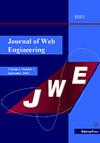基于深度学习和多标准分析的稳健云服务排名
IF 1
4区 计算机科学
Q4 COMPUTER SCIENCE, SOFTWARE ENGINEERING
引用次数: 0
摘要
随着云服务的快速增长,根据性能、可靠性和安全性对这些服务进行评级的强大评估方法至关重要。本研究介绍了一种利用先进的深度学习(DL)算法来优先考虑和评估云服务的整体方法。我们的模型包含许多评估标准,包括延迟、吞吐量、可用性和安全措施。使用来自云服务的各种性能度量集合来训练这些标准。我们通过综合实验验证了我们方法的有效性,与传统方法相比,在排名方面获得了更高的精度和显著性。使用测试集对DL模型进行评估,得出排名分数的平均绝对误差(MAE)为0.15。与传统的排名方法相比,该算法经常取得更好的结果,特别是在性能指标变化的情况下。通过整合安全指标,该模型不仅根据云服务提供商(csp)的性能,还根据其抵御安全威胁的能力,成功地对其进行了评估和排名。DL技术在其排名中表现出更大的灵活性和上下文意识,因此显示出其在适应实时数据方面的优势。该研究将基于dl的排名与传统方法和行业标准进行了比较,证明了其在有效适应实时数据方面的优势。研究技术需要从许多云计算服务提供商收集数据,以构建一个弹性框架,用于使用DL模型评估云服务。这些数据来自公开可用的性能统计数据、云监控工具、用户评估和问题报告。该集合包括结构化和非结构化数据,包括基本的性能和准确性指标。本文章由计算机程序翻译,如有差异,请以英文原文为准。
Robust Cloud Service Ranking with Deep Learning and Multi-Criteria Analysis
With the rapid growth of cloud services, it is crucial to have strong assessment methods in place to rate these services according to their performance, dependability, and security. This study introduces a holistic methodology that utilizes advanced deep learning (DL) algorithms to prioritize and evaluate cloud services. Our model incorporates many assessment criteria, including latency, throughput, availability, and security measures. These criteria are trained using a varied collection of performance measurements from cloud services. We validate the effectiveness of our methodology by comprehensive experiments, attaining greater precision and significance in ranking compared to conventional approaches. The DL model underwent evaluation using a testing set, resulting in a mean absolute error (MAE) of 0.15 in ranking scores. The algorithm regularly achieved superior results compared to conventional ranking approaches, particularly in situations where performance measures varied. Through the incorporation of security metrics, the model successfully assessed and ranked cloud service providers (CSPs) based not only on their performance, but also on their ability to withstand security threats. The DL technique exhibited more flexibility and contextual awareness in its rankings, hence showcasing its superiority in adjusting to real-time data. The research conducted a comparison between DL-based rankings and conventional methodologies and industry standards, demonstrating its superiority in effectively adjusting to real-time data. The study technique entails gathering data from many CSPs to construct a resilient framework for evaluating cloud services using DL models. The data is obtained from publicly available performance statistics, cloud monitoring tools, user evaluations, and problem reports. The collection comprises both structured and unstructured data, including essential performance and accuracy indicators.
求助全文
通过发布文献求助,成功后即可免费获取论文全文。
去求助
来源期刊

Journal of Web Engineering
工程技术-计算机:理论方法
CiteScore
1.80
自引率
12.50%
发文量
62
审稿时长
9 months
期刊介绍:
The World Wide Web and its associated technologies have become a major implementation and delivery platform for a large variety of applications, ranging from simple institutional information Web sites to sophisticated supply-chain management systems, financial applications, e-government, distance learning, and entertainment, among others. Such applications, in addition to their intrinsic functionality, also exhibit the more complex behavior of distributed applications.
 求助内容:
求助内容: 应助结果提醒方式:
应助结果提醒方式:


